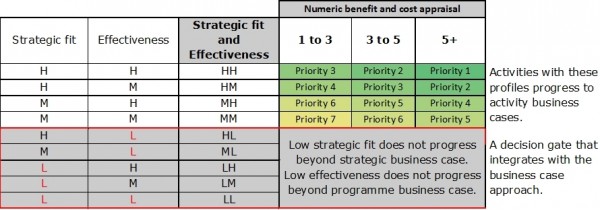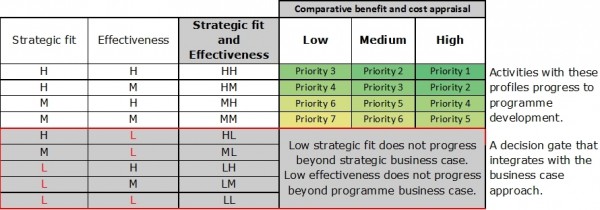The strategic fit, effectiveness and benefit and cost appraisal are brought together to form an assessment profile, which is used to prioritise activities in the National Land Transport Programme (NLTP).
The Transport Agency, in the development of the NLTP and in its investment decisions, will review the assessments made and prioritise activities within each activity class using their assessment profiles. Additional factors identified may be taken into consideration.
Only programmes and activities assessed with at least a medium strategic fit and medium effectiveness will progress to prioritisation.
Programmes and activities assessed as having low strategic fit should remain at the strategic business case stage and programmes and activities assessed as having low effectiveness should not progress beyond the programme business case.
A prioritisation table is used that lists all possible profiles and assigns a priority based on:
The following table shows the priority order of assessment profiles for improvements to local roads, state highways, public transport, and walking and cycling.

Improvement projects that have yet to be approved, other than minor improvements, are assessed and prioritised in two stages:
The following table shows the priority order of assessment profiles for programmes of work for public transport services, maintenance, and road safety promotion.

Programmed activities, including public transport services, road maintenance, road safety promotion and minor improvements programmes, are assessed by the programme owner. This is taken into account by the Transport Agency in making its assessment and determining its assessment profile. Sufficient information usually exists at the time of including these activities in the NLTP to also make the investment decision and approve their funding, most often for all three years of the NLTP.
As a rule, NLTF funds are allocated to the highest priority activities in the National Land Transport Programme first.
Any remaining regionally distributed (R) funds are allocated to the highest priority improvement projects in each region until the funds are fully allocated. Under the legacy R funding policy, projects with low strategic fit and/or effectiveness may be allocated R funds if they are of highest priority in the region. Collection of R funds ceased on 31 March 2015. The Transport Agency Board has resolved that the term for their expenditure expires 30 June 2018, except for Nelson which has until 30 June 2021. R funds can be allocated to the following activity classes, including minor improvements:
Crown (C) funds appropriated prior to full hypothecation of the NLTF, and now included in the NLTF, are allocated to the highest priority activities pertinent to the specified purpose for which they were originally appropriated.
Remaining projects are allocated nationally distributed (N) funds in each activity class until the total allocation of funds to that activity class is fully provided. The Transport Agency will decide the funding allocations to each activity class within the range defined by the Government Policy Statement on Land Transport.
The priority order at which funding becomes fully allocated to an activity class is the funding threshold.
The threshold priority order for funding in each activity class (and region) depends on the funds allocated to each activity class and the priority of the candidate activities.
|
Activity Class |
Investment threshold -funding priority order |
|
State highway improvements (metropolitan areas, see Regional Improvements activity class for list of areas) |
4 |
|
State highway improvements (non-metropolitan areas) |
2 |
|
Local road improvements |
7 |
|
Public transport improvements |
6 |
| Walking & cycling improvements | 6 |
| Regional improvements | 3 (upper) – 6 (lower) |
| Transport planning | 4 |
The Transport Agency categorises improvement activities under the following funding priorities, based on their priority order.
Committed activities do not have to be prioritised because they have already been approved by the Transport Agency.
Crown appropriations outside of the NLTF, such as the Accelerated Regional State Highway Programme, will be allocated to the specified activities or according to the allocation rules applicable to each appropriation.